New Tibicen auletes photos from Elias Bonaros.
The Tibicen auletes aka Northern Dusk-singing Cicada is the largest of the Tibicen cicadas in the U.S.A.
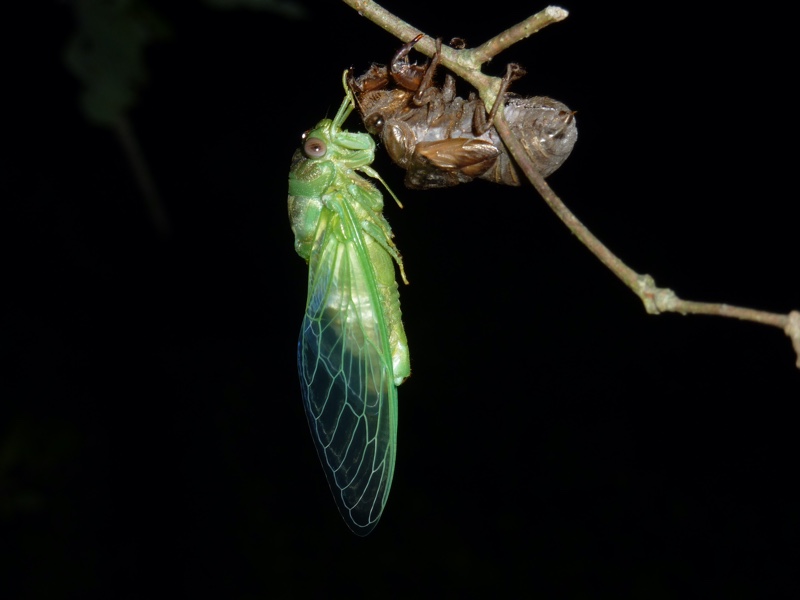
Dedicated to cicadas, the most amazing insects in the world.
New Tibicen auletes photos from Elias Bonaros.
The Tibicen auletes aka Northern Dusk-singing Cicada is the largest of the Tibicen cicadas in the U.S.A.

C is for Cicada Killer Wasp. The Cicada Killer Wasp (in North America, Sphecius speciosus) is a large wasp, which captures adult cicadas, paralyzes them, places them in a burrow, and then lays an egg on them. The cicada dies as it is consumed by the developing wasp larvae. If you want to learn more about these wasps, visit Prof. Chuck Holiday’s Cicada Killer Wasp Website.
As you might guess from Elias Bonaros’ photo, Cicada Killer Wasps are less aggressive towards humans than other wasps, however, we do not recommend approaching them, particularly, if you are a cicada.
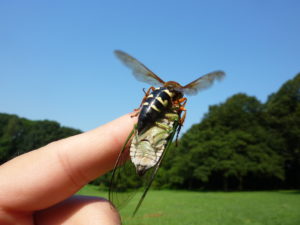
More (lots more):
Cacama valvata is a species of cicada found in the South-Western United States.
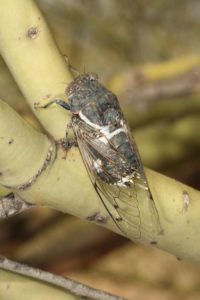
Cacama valvata photo by Adam Fleishman.
The Canadian Cicada, aka Okanagana canadensis, is a species of cicada found in Canada.
The Carineta diardi is arguably the most beautiful cicada of all. C. diardi exist in Brazil. Their black, red, green bodies and yellow tinted wings are amazing to behold.
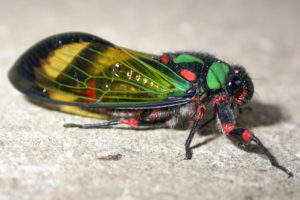
Photo by Pia Öberg.
A chimney (aka a turret) is a chimney-like structure that a cicada builds above the hole it will emerge from when it’s ready to become an adult. Cicada researchers look for chimneys to get an idea where cicadas will emerge.
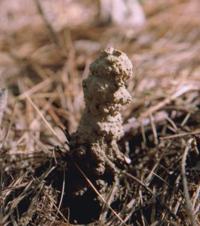
Cicadetta calliope (formerly Melampsalta calliope) is a species of cicada found in the South-Eastern United States. It is rust-orange and black, and its eyes are a pretty rose color.
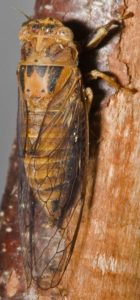
Photo by Paul Krombholz.
The clypeus is that bulbous structure on the cicada’s head that looks like it could be the cicada’s nose or the grill of a 1950’s automobile. The clypeus holds the muscles the cicada uses to pump plant fluids through its needle-like beak and to its digestive system. Clypeus means shield in Latin.

John Cooley is one of the premier cicada researchers working today. Visit John’s site Cicadas @ UCONN (formerly Magicicada.org), which is dedicated to re-mapping the location of Magicicada broods.
The cruciform elevation is a cross-shaped structure on the dorsal posterior portion of a cicada’s thorax:

Cryptotympana is a genius of cicadas which exist in Asian countries like Thailand. 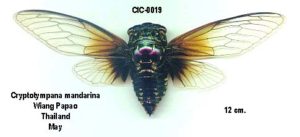
Photo by Michel Chantraine.
B is for Brood. Here’s the basics:
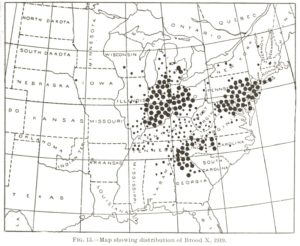 Magicicada cicadas are American periodical cicadas that have 17 or 13 year life cycles. There are 12 groups of Magicicadas with 17 year life cycles, and 3 groups of Magicicadas with 13 year life cycles. Each of these groups emerge in a specific series of years, rarely overlapping (17 year groups co-emerge every 289 years). Each of these groups emerge in the same geographic area their parents emerged. These groups, each assigned a specific Roman numeral, are called broods.
Magicicada cicadas are American periodical cicadas that have 17 or 13 year life cycles. There are 12 groups of Magicicadas with 17 year life cycles, and 3 groups of Magicicadas with 13 year life cycles. Each of these groups emerge in a specific series of years, rarely overlapping (17 year groups co-emerge every 289 years). Each of these groups emerge in the same geographic area their parents emerged. These groups, each assigned a specific Roman numeral, are called broods.
Two examples:
Brood X (X is the Roman numeral for 10), emerges every 17 years, in DE, GA, IL, IN, KY, MD, MI, NC, NJ, NY, OH, PA, TN, VA, & WV. The last time Brood X emerged was in 2004, and it will emerge again in 2021.
Brood XIX (19) emerges every 13 years, in AL, AR, GA, IN, IL, KY, LA, MO, MS, NC, OK, SC, TN, VA. The last time Brood XIX emerged was 1998, and it will emerge next in 2011 (NEXT YEAR)!
When is the next Brood emerging in your area? Consult the Brood Chart.
I’ve only scraped the surface about the who, why, when, where and how of Broods. If you want to learn more I highly recommend Gene Kritsky’s book Periodical Cicadas: The Plague and the Puzzle. There are also online resources such as Cicadas @ UCONN (formerly Magicicada.org), which has updated brood maps, and Cicada Central.
More cicada alphabet:
A is for antennae. Cicadae antennae are situated between their eyes and their clypeus. Insects use their antennae to smell and sense touch, temperature, and vibration.
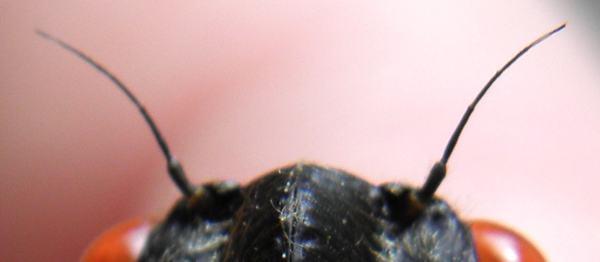
More:
Abricta curvicosta: The Abricta curvicosta is an Australian cicada also known as the Floury Baker (because its abdomen appears to be floury). You can find this cicada in eastern Australia. Here’s a photo of an A. curvicosta:
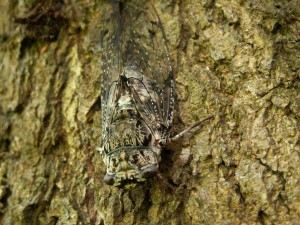
Floury Baker by Michelle Thompson.
Visit Brisbane cicadas for more photos, information and audio.
Ambragaeana ambra: The Ambragaeana ambra is a cicada that can be found in Thailand. This cicada has remarkable brown, yellow, orange and black colored wings. Here’s a photo of an Ambragaeana ambra:
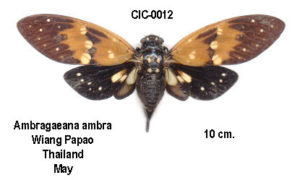
Ambragaeana ambra photo by Michel Chantraine.
Angamiana floridula: The Angamiana floridula is a cicada that can be found in Thailand. This cicada has orange, brown & cream colored wings. Here’s a photo of an Angamiana floridula.
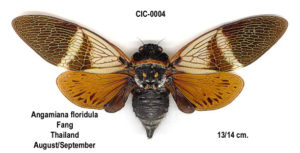
Angamiana floridula photo by Michel Chantraine.
Arunta perulata: The Arunta perulata is an Australian cicada also know as the White Drummer. This cicada can be found in eastern Australia. They’re known for their pronounced sack-like tymbal covers (the white drums?). Here’s a photo of an Arunta perulata:
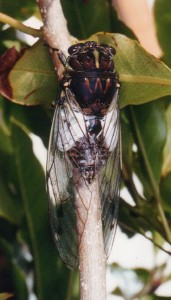
White Drummer cicada (Arunta perulata). Photo by David Emery.
Visit the CSIRO website for more information and an illustration.
Ayuthia spectabile: The Ayuthia spectabile is a cicada than can be found in Thailand. This cicada’s coloration features cream, light brown, black and mint green. Here’s a photo of an Ayuthia spectabile:
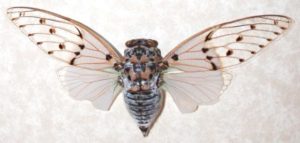
To learn more about Australian cicadas, try the book Australian Cicadas by M.S. Moulds, or online at Brisbane Cicadas.
This is the start of a new feature on Cicada Mania called the Cicada Alphabet.
Temperature is a factor influencing when cicadas will emerge from the earth and enter the adult phase of their lives. Cicadas like warm weather (as do most insects) and so once the soil & air reaches a temperature that pleases the cicadas, they will likely emerge. There are other factors of course, but hotter weather usually means cicadas will emerge sooner than later.
The spring and summer of 2010 have been HOTTER than usual in the mid-Atlantic area of the United States, and so species of cicadas are emerging earlier than expected. Since June first, I’ve witnessed, 32 days above 80F(27C), and 11 days above 90F(32C), in New Jersey, which is warmer than usual.
Annual cicada species like the Tibicen species and Neocicada hieroglyphica have been emerging sooner than expected. Cicadas.info has reports of Neocicada hieroglyphica, Tibicen lyricen and T. tibicen (T. chloromera) emerging sooner than expected. I’ve been hearing T. linnei in New Jersey since June.
Massachusetts Cicadas is reporting a slow start for Tibicen. Massachusetts is a New England state and is typically cooler than Mid-Atlantic states like New Jersey, but that might not be the only factor at work here. It will be interesting to see how this plays out.
What else…
The temperature will also affect when a cicada will sing: if it’s too cold cicadas won’t sing, and if it’s too hot the poor over-heated cicadas won’t sing. This is why you won’t hear some annual cicadas singing on a cool day, or when it’s near 100F(38C). This depends on the species too; some species like it HOT, and some like it cool.
I’ve also heard that temperature can affect the frequency of a cicada’s song, however, there is not a formula that allows to you determine the temperature based on the pauses in a cicada’s call like there is for crickets.
The Okanagana rimosa, also known as Say’s Cicada, is a cicada that can be found in the USA in northern states east of the Rockies, like New York, Pennsylvania, Michigan, Wisconsin, Minnesota, North Dakota and all New England states. Say’s cicada can also be found in the Quebec, Ontario, and Manitoba provinces of Canada.
Say’s Cicada is black and orange; orange legs, orange markings on its mesonotum, and orange bands around most segments of its body. Here’s a photo of an adult:
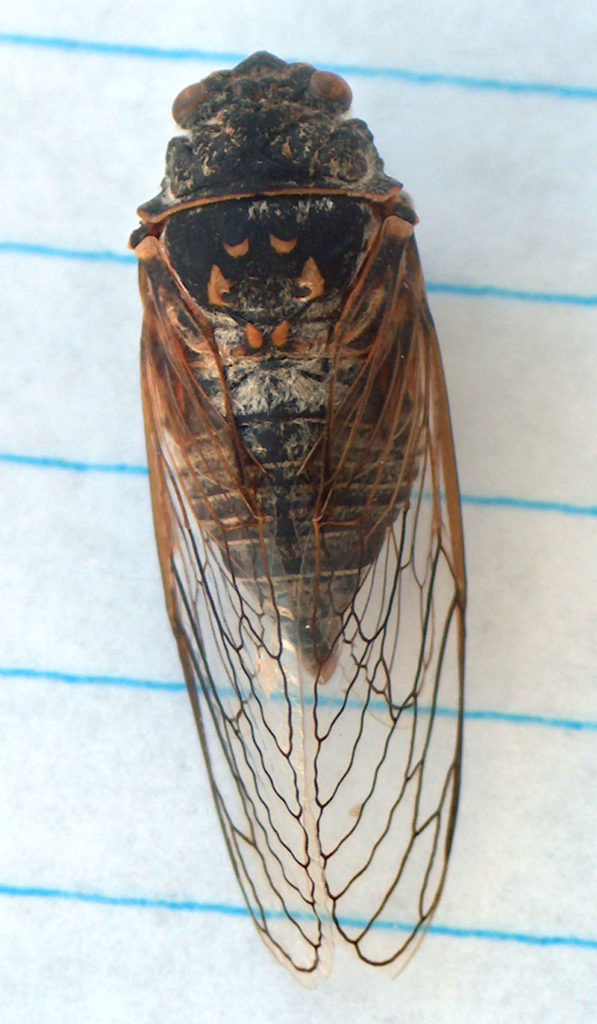
A few weeks ago Elias Bonaros sent us some photos of the exuvia (shed skins) of Okanagana rimosa nymphs that he found while searching for cicadas in Western Massachusetts with Gerry from Massachusetts Cicadas. It’s interesting that the black bands that appear around the segments of the nymph’s body are where we see orange bands in the adult form.
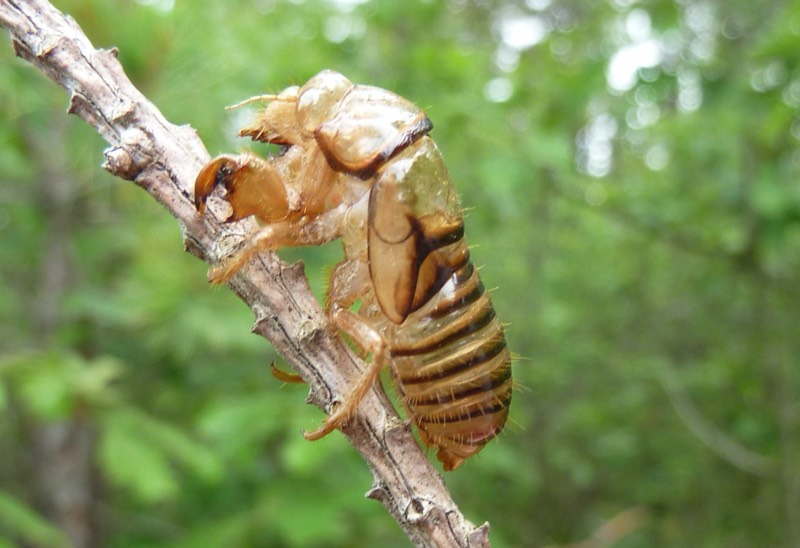
Say’s cicada has a fantastic call that needs to be heard to be appreciated. Visit the Insect Singers website to hear the call of a Okanagana rimosa.
An interesting note about the Okanagana rimosa, it has been showed to have a 9 year life cycle, and appears to be protoperiodical:
“Soper et al (112) showed experimentally that Okanagana rimosa had a life
cycle of 9 years, and that in the field during a 9-year period (1962 to
1970) it was extremely abundant in 4 years and scarce or absent in the
other 5. Heath (32) also studied cicadas of the genus Okanagana and
found several species that appear to be protoperiodical.”
Magicicada Discussions from 2010
Note: no major broods emerged in 2010.
I wanted to mention that I heard several Periodicals(cassini) in blue springs around the first week of June. Maybe a total of about 15 0r 20 in 2 trees.
Comment by Steve Karan — July 1, 2010 [AT] 2:01 pm
Heard a cassini singing in the trees for about 45 minutes today in Loveland. It was finally sunny and warm enough for it after 7 days of cool weather.
Comment by Roy Troutman — May 22, 2010 [AT] 6:15 pm
May 15, 2010 M cassini, Milford, OH (Cincinnati)
Comment by Jennifer Taylor — May 14, 2010 [AT] 7:53 am
I forgot to mention that the greenway is located in Charlotte, North Carolina. The largest concentration of cicadas was observed between the 3-mile and 3.25-mile markers (between Johnston Rd and Hwy 51). Also, several adults had the Massospora cicadina fungal disease.
Comment by Lenny Lampel — May 11, 2010 [AT] 6:05 am
I observed a small emergence of one year early stragglers of Brood XIX on Monday, May 10. There were several dozen calling along a one mile stretch of the Lower McAlpine Greenway. The emergence appeared to be entirely Magicicada tredecassini. Interestingly, the emergence occurred in a floodplain forest. Good numbers of exuviae were observed on wetland shrubs and grasses and numerous live adults were on the ground and flying between trees. Several grackles were seen eating the cicadas and yellow-billed cuckoos and great-crested flycatchers were also in the area and were extremely vocal.
Comment by Lenny Lampel — May 11, 2010 [AT] 5:59 am